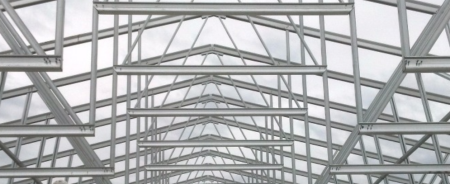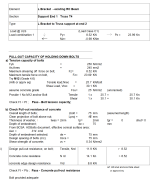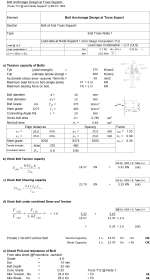Anchorage Bolt at Truss Support

Description
Design of Anchorage Bolt at Truss Support to BS En 1993. Spreadsheet to check and input of MS anchorage bolt at the end of a truss. The input value required are the bolt data. The spreadsheet check the (i) bolt tension (ii) shearing capacity and (iii) combined shear and torsion of the bolt. All input units are in SI units. The spreadsheet is in compliance to BS En 1993.
The design of an anchorage bolt at the end of a truss, following the requirements of BS EN 1993 (Eurocode 3), involves checking the bolt tension, shearing capacity, and the combined shear and torsion of the bolt. Here's a summary of the design process:
-
Bolt Tension Check: The tension capacity of the bolt is determined by considering the material properties and geometrical characteristics of the bolt. The applied tensile force, including any additional loads or dynamic effects, is compared to the bolt's tensile capacity to ensure it is within acceptable limits.
-
Shearing Capacity Check: The shearing capacity of the bolt is evaluated to ensure that it can withstand the applied shear forces. This involves considering the shear area of the bolt, which is determined based on its effective diameter or thread engagement length, and comparing it to the shear force acting on the bolt.
-
Combined Shear and Torsion Check: If the bolt is subjected to both shear and torsion simultaneously, a combined shear and torsion check is performed. This involves calculating the combined shear and torsion effects using appropriate interaction formulas and comparing them to the bolt's capacity.
-
Material Properties: The design calculations require knowledge of the bolt's material properties, such as yield strength, ultimate tensile strength, and shear strength. These properties can be obtained from the relevant standards or specifications.
-
Design Factors: Design factors or safety factors are applied to the bolt's capacity to ensure a sufficient margin of safety. These factors account for uncertainties in material properties, workmanship, and other factors that may affect the actual performance of the bolt.
-
Bolt Installation and Embedment: The design should also consider the proper installation and embedment of the bolt to achieve the desired performance. The bolt length, embedment depth, and the presence of any additional reinforcement or anchoring elements are evaluated to ensure proper load transfer and anchorage.
Calculation Preview
Full download access to any calculation is available to users with a paid or awarded subscription (XLC Pro).
Subscriptions are free to contributors to the site, alternatively they can be purchased.
Click here for information on subscriptions.



